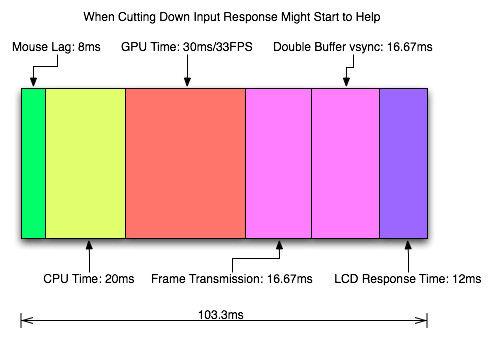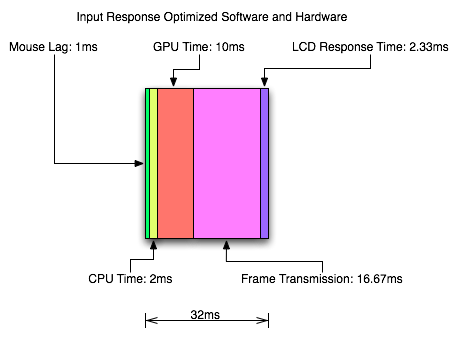Combating Input Lag and Final Words
Now that we know what's going on and what the factors are, what can we do about it?

Sometimes 1ms can be the difference between your input getting to the software in time to be included in the next frame. Most of the time it won't. Of course, the difference between 8ms and 2ms could actually make a frame of difference (up to 16.67ms) in input lag. A mouse that can handle 500 reports/second is what we recommend as a good balance.
It is possible to overclock your mouse. You will still be limited by the physical capabilities of the mouse, but running the USB port for the mouse at a higher rate can help, especially if you don't want to invest in a more expensive mouse. There are tools out there to both check your mouse report rate (with Direct Input Mouse Rate) and to change the rate by replacing the usb driver. When changing the rate on Vista SP1 or Windows 7, drivers will need to be signed. This can be accomplished by using testing signatures and forcing windows to load them. NGOHQ offers a good tutorial on this here.
CPU, memory and GPU will impact the input lag between the mouse and the display. The GPU, as the main internal bottleneck in games, will likely have the largest single impact (higher framerate means less time between frames and less lag), but this is heavily dependent on game design. The basic recommendation is a modestly priced dual core CPU, inexpensive RAM, and a fast GPU. Faster CPUs and RAM could potentially benefit but will not likely provide a huge return on investment in this case.
For input lag reduction in the general case, we recommend disabling vsync. For NVIDIA card owners running OpenGL games, forcing triple buffering in the driver will provide a better visual experience with no tearing and will always start rendering the same frame that would start rendering with vsync disabled. Only input latency after the time we would see a tear in the frame would be longer, and this by less than a full frame of latency.
Unfortunately, all other implementations that call themselves triple buffering are actually one frame flip queues at this point. One frame render ahead is fine at framerates lower than the monitor refresh, but if the framerate ever goes past refresh you will experience much more input lag than with vsync alone. For everyone without multiGPU soluitons, we recommend setting flip queue or max pre-rendered frames to either 1 or 0. Set it to 1 if framerate is always less than monitor refresh and set it to 0 if framerate is always greater than or equal to monitor refresh. If it goes back and forth, only NVIDIA's OpenGL triple buffering will provide the best of both worlds without tearing and will further reduce input lag in high framerate situations.
Improperly handling vsync (enabling or disabling a 1 frame flip queue at the wrong time) can degrade performance by at least one additional whole frame. But with multiGPU options, we really don't have a choice. With more than one GPU in the system, you will want to leave maximum pre-rendered frames set to the default of 3 and allow the driver to handle everything. Input lag with multiGPU systems is something we will want to explore at a later time.
You will want a monitor that doesn't do much (if any) processing. Preferably with a "game" mode. We recently took a look at a few monitors to get a feel for the difference in input processing. While we didn't test it in this article, adding another 16ms to 33ms to input lag is just not a good idea.

One of the largest benefits to games that don't inherently carry a lot of input lag is refresh rate. A real 120Hz refresh rate can significantly benefit input lag especially in twitch shooters. While that impact would be less in games where the framerate can't keep up, the hail of additional frames that can be incurred between the computer and the monitor will still be significantly impacted. Additionally, vsync (even in the worst case) is much cheaper on a high refresh rate monitor. Triple buffering (or even 1 frame flip queues with performance lower than refresh) and 120Hz monitors are a match made in heaven.
Final Words
What started out as a short article on the concept of input lag ended up touching on quite a few key issues in gaming. We get into a few of the concepts of game design and program flow in addition to looking at hardware impact. While we hadn't planned on it, picking up a camera that can do 1200 FPS allowed us to actually measure the input lag of a couple real games.
There are quite a few good nuggets to take away. First, input lag is hugely dependent on the game. There will be games that optimize for reducing input lag and others that do not. In some games it is more important than others. For games that incur huge amounts of input lag, there is only so much that can be done. Using the tips we provided will definitely help get people on the path to lower input lag.
Unfortunately, sometimes reducing input lag to its minimum requires spending money especially on the display side of things. Just make sure to read reviews that look at display lag as avoiding a display that adds an extra 16ms to 33ms of input lag is definitely a good start. Beyond that, a faster GPU is the next most important upgrade, and a mouse that can do at least 500 reports per second is a good idea.










85 Comments
View All Comments
Zolcos - Thursday, July 16, 2009 - link
The article is logically inconsistent. On page 1 it states "input lag is defined as the delay between the when a user does something with an input device and when that action is reflected on the monitor" and on page two it has "Input lag starts from before we even react".DerekWilson - Thursday, July 16, 2009 - link
i'll fix that..."The impact of input lag is compounded by what goes on before we even react."
yacoub - Thursday, July 16, 2009 - link
The input lag everyone's most concerned with is the amount the display adds, because while all the rest is consistent, displays add a variable amount depending on which one you get. The ones that add more than ~20 ms add a NOTICEABLE amount (for most people) which takes input lag to the point that it becomes frustrating.DerekWilson - Thursday, July 16, 2009 - link
Part of the point was to explain that there is a lot at the end of the chain that can significantly impact performance and it's all about the display.If we do consider a 100ms threshold as valid, then based on our numbers from TF2 it is clear that we would end up in the >100ms input lag range with a monitor that adds more than 20ms of lag.
And if we can't expect a twitch shooter to come in under the mark, how is everything else going to do? Not well I would imagine.
I did think about looking at a wide array of monitors, but I feel like that might be better suited to a more focused review of monitor performance rather than an exploration of input lag in general.
yacoub - Thursday, July 16, 2009 - link
Sure but for whatever reason, all of the lag prior to the display's lag is essentially transparent because it doesn't add up to be enough to be perceptible. This would equate to your threshold.When using a display with little or no noticeable display lag, any FPS game will feel very responsive and without discernible latency (assuming your GPU hardware is up to the task of rendering the frames quickly enough and you're not using one of the early optical mice from a decade ago that had terrible tracking refresh rates, etc etc).
Yet simply switching to a display with higher latency is enough to make input latency noticeable and frustrating for FPS gamers. So the key issue is finding a TN or IPS display since those panel technologies have the least input lag. Of course most panels out there are -VA based panels because they are cheaper to produce than IPS, and TN may be snappy in display response but they have a number of other downsides.
What matters most is getting panel makers focused on IPS-based displays (or new panel technologies that significantly reduce the input lag most non-TN displays presently suffer. And hey, the more they produce and sell, the lower the production cost per unit so the better the pricing can be and the more opportunities for improved technology to be added to the IPS design.
ocyl - Friday, July 17, 2009 - link
@ yacoubDid you read the article at all?
yacoub - Friday, July 17, 2009 - link
Yes. I must not be explaining myself well, so forget it.DDuckMan - Saturday, December 18, 2010 - link
While this article was great, I'm still not sure if I am better off disabling SLI to eliminate the syncronization lag or having the higher framerates with SLI enabled in twitch games. It seems to me that with 120Hz monitors, vsync (which I need for 3D) and SLI lag would not be as important as keeping the framerate above the monitor refresh rate. I don't have the equipment to properly test, so I am looking forward the the next article.http://hardforum.com/showthread.php?t=1569281
burner1980 - Thursday, March 10, 2011 - link
Quote: "Input lag with multiGPU systems is something we will want to explore at a later time."I`m still waiting patiently and looking forward to a follow up investigation. The topic of input lag is VERY important to gamers who play FPS. I do notice it in racing games, too.
I suggest to use true 120Hz monitors in the follow up article. They of course won`t reduce input lag, but help to reduce screen tearing and thus allowing to optimize one`s settings to reduce input lag while keeping screen tearing at a low enough level.
I´m also courious if using a 3 screen setup a la Eyefinity oder Vision Surround using two GPUs will have an impact.
dmnwlv - Thursday, April 28, 2011 - link
Impressive report.Regarding mouse polling rate (I may have missed it out):
1) I believe the actual mouse input into the CPU is already calculated and the end result (of that action) already registered before you get to see it on screen. It does not wait for the GPU/monitor to finish processing before determining the end result. Hence the influence of mouse response is even more substantial if we take out the whole chunk of lag times that were included in the total lag calculation here - Derek Wilson, pls correct me if I am wrong.
Coupled with the predictive ability of human (also reported here) to react accordingly in advance from the existing state of game situation, it seems to match and explain why it is hard to imagine a few milliseconds of difference in mouse lag can have an impact to the overall gaming experience. The brain and reaction is (trying its best) interpolating and working in tandem with the CPU than the monitor.
2) And another scenario where the user already intended to do a series of / continuous / extended action (eg, drawing a long curve line), does the response rate of the mouse play a part in drawing the most accurate curve that the person input/intended? - Maybe Derek can help on this as well.
Thanks for the great report.